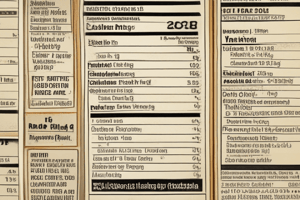Podcast
Questions and Answers
Which component of a food label provides information about the suggested portion size of the food product?
Which component of a food label provides information about the suggested portion size of the food product?
- Nutrients
- Calories
- Ingredients
- Serving Size (correct)
What does the number of calories per serving on a food label indicate?
What does the number of calories per serving on a food label indicate?
- The taste of the food product
- The expiration date of the food product
- The amount of energy the food provides (correct)
- The weight of the food product
What does the % Daily Value (%DV) represent on a food label?
What does the % Daily Value (%DV) represent on a food label?
- The expiration date of the food product
- The total amount of nutrients in the food product
- The percentage of calories in the food product
- The proportion of a specific nutrient in one serving compared to the recommended daily intake (correct)
What does the ingredient list on a food label provide?
What does the ingredient list on a food label provide?
Why is it important to be mindful of the serving size when comparing different food products?
Why is it important to be mindful of the serving size when comparing different food products?
Which of the following is a common allergen that is highlighted on food labels?
Which of the following is a common allergen that is highlighted on food labels?
What information do food labels provide about additives and preservatives?
What information do food labels provide about additives and preservatives?
What do health claims on food labels provide?
What do health claims on food labels provide?
What can happen if individuals do not know how to read food labels?
What can happen if individuals do not know how to read food labels?
Why are food labels considered indispensable tools for making informed choices?
Why are food labels considered indispensable tools for making informed choices?
True or false: Food labels provide information about common allergens such as peanuts and shellfish.
True or false: Food labels provide information about common allergens such as peanuts and shellfish.
True or false: Health claims on food labels are regulated by food authorities.
True or false: Health claims on food labels are regulated by food authorities.
True or false: Not knowing how to read food labels can lead to poor nutritional choices and increased risk of chronic diseases.
True or false: Not knowing how to read food labels can lead to poor nutritional choices and increased risk of chronic diseases.
Match the following information found on food labels with their descriptions:
Match the following information found on food labels with their descriptions:
Match the reasons for knowing how to read food labels with their explanations:
Match the reasons for knowing how to read food labels with their explanations:
Match the consequences of not knowing how to read food labels with their outcomes:
Match the consequences of not knowing how to read food labels with their outcomes:
Flashcards are hidden until you start studying




